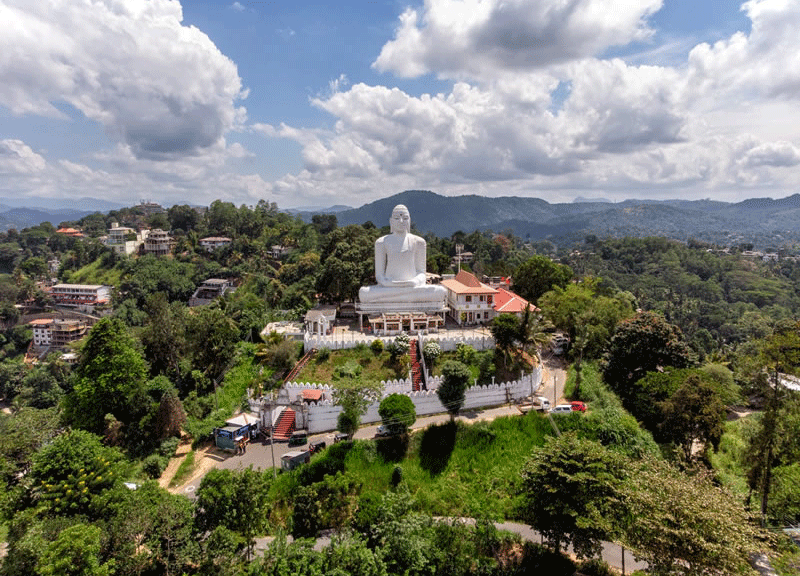The biggest attraction in Kandy, as the locals call it, is Sri Dalada Maligawa. In fact, buses packed with tourists stop in Kandy solely to see this unique Buddhist temple. What a great way to discover the former capital of the Sri Lankan monarchs!
Table of Contents
- Kandy has 11 activities. In addition to the Tooth Relic Temple,
- Temple of the tooth relic
- Crossing the Knuckles Mountain Range
- Hanthana Mountain Range Trekking
- Temple of Lankathilaka
- Temple of Embekke
- Temple of Gadaladeniya
- The Royal Botanical Gardens of Peradeniya
- Peradeniya University
- The Biodiversity Complex of Ambuluwawa
- Saradiel Town
- International Buddhist Centre of Nelligala
- Kandy Restaurants
Kandy has 11 activities. In addition to the Tooth Relic Temple,
I swear I’ll lose it if I come across any more blog posts advising walking around the city lake as one of the best things to do in Kandy. The lake is nice, but you’ll probably pass it ten or more times a day because it’s situated in the middle of town, near the Temple of the Tooth Relic.
Temple of the tooth relic
The biggest attraction in Kandy, as the locals call it, is Sri Dalada Maligawa. In fact, buses packed with tourists stop in Kandy solely to see this unique Buddhist temple. What a great way to discover the former capital of the Sri Lankan monarchs!
Due to its importance, the temple of the tooth relic is packed into most Sri Lankan tour packages, such as 10-day Sri Lankan tours, 7-day Sri Lankan tours, and most other multi-day tour packages. The travelers can book a standalone trip to Kandy, such as a Kandy one-day trip to visit the tooth relic temple. Or else they can book a multi-day Sri Lanka trip that includes Kandy and the tooth-relic temple. Tour operators such as Seerendipity Tours offer daily trips to Kandy from Colombo and many other beach resorts.
Most visitors to Kandy on their first visit visit the Temple of the Tooth and the lake I described previously. Not surprisingly. This Buddhist temple is busy and exudes a strong spiritual vibe, which is complemented by its majesty and splendour. Despite the fact that most temples in Sri Lanka do not charge visitors, the Temple of the Tooth Relic will charge international visitors a fee of 2000 rupees.
This is not meant to deter you from visiting the temple. I believe the temple is required. You just need to visit it once, just like the Eiffel Tower in Paris or Red Square in Moscow, no matter how long the queues are at the ticket counter. But don’t stop there; Kandy offers a plethora of fantastic things to do.
Crossing the Knuckles Mountain Range
When it comes to trekking and mountain exploration in Sri Lanka, Nuwara Eliya and Ella are two of the first places that come to mind for visitors. Few people are aware that Kandy may serve as a comfortable base from which to visit the magnificent Knuckles Mountain Range. When viewed from some points in Kandy, the early British explorers dubbed this range by the way it resembles the knuckles of a closed fist. The Misty Mountain Range is what the locals call it.
Going knuckles only is not a recommended method. Unlike national parks and forests in developed countries, Sri Lanka’s national parks are not always accessible to tourists. There are no signs directing you, no clear paths, and no one within miles to seek for assistance.
It is strongly advised that you hire a driver or guide for your Sri Lanka nature discovery excursion. Call the travel agency Seerendipity Tours and ask for a guide to show you around. It is entirely up to you how long you wish to spend on the stroll. Although you could climb for several days and camp in the mountains, some travellers prefer to go up and down in a single day.
Hanthana Mountain Range Trekking
If you’re in Kandy, the Hanthana Mountain Range is an excellent area to go hiking. There are seven peaks in total, with the highest being 3,800 feet tall Uura Kanda. Hanthana’s base is closer than Knuckles’; it just take thirty minutes to get there.
There are several treks and seven summits to select from, so the book should help you make an informed decision. The three-hour walking tour of Hantana is often easy; visitors stroll through lovely sun-lit tea plantations, ascend to a hill overlooking the valley, then return via the jungle.
Temple of Lankathilaka
The two temples listed below, together with Lankathilaka Temple, are located outside of Kandy but not far apart. They provide a more accurate representation of the ambiance of Buddhist temples in Sri Lanka than the Temple of the Tooth Relic.
Many visitors believe that Lankathilaka is the best of the three. Udunuwara, the site of this historic temple established by King Bhuvanekabahu IV in the fourteenth century, is about thirty minutes’ drive from Kandy.
The temple was constructed on an uneven rock surface known as Panhalgala. Lankathilaka, along with Embekke Temple, is regarded as one of the most technically complicated structures from the Gampola Kingdom period.
Temple of Embekke
Embekke Devalaya is one of the most peculiar Buddhist temples in Sri Lanka. Woodcarvings embellish the rafters, doorways, beams, and pillars. While most Sri Lankan temples are made of stone or brick, Embekke’s exquisite wooden pillars remind visitors of Russia, where wood carving has been practised for centuries.
Embekke was constructed in the fourteenth century by King Vikramabahu III during the Gampola Era. Its three main components are the Drummers’ Hall, the Dancing Hall, and the Sanctum of Garagha. The latter is the one with the pillars.
Temple of Gadaladeniya
King Bhuvanekabahu IV built Gadaladeniya Temple, which is near to Lankathilaka Temple and can be reached after a short drive, in 1344. The temple was created by an Indian architect and was originally called as Dharma Kirthi Viharaya, after the founder monk. Its design was particularly South Indian.
Despite their proximity, the three temples—Lankathilaka, Embekke, and Gadaladeniya—are located outside of Kandy city. If you wish to tour all three temples in a same day, renting a tuk-tuk for three or four hours is preferable. For around 5000 rupees.
If you don’t want to leave Kandy, another, less visited temple is Bahirawakanda Viharaya. The huge Buddha monument, perched atop a hill in the heart of Kandy, can be seen from practically anywhere. This Buddha statue is one of the highest in Sri Lanka, standing at 88 feet. This temple was built in the 1970s, thus it is relatively recent.
If you’re physically fit, you can walk up the slope. It’s a short but steep ascent. Fortunately, there is a small stand directly in front of the temple where you can purchase king coconuts. Taking a tuk-tuk is a slightly easier and less taxing choice.
The Royal Botanical Gardens of Peradeniya
The Royal Botanical Gardens, located approximately five miles from Kandy in the city of Peradeniya, is a famous tourist destination. You can easily get here in fifteen minutes by tuk-tuk. The garden receives over two million visitors every year.
The gardens cover 147 acres and are located near the Mahaweli, Sri Lanka’s longest river. Their history is thought to have begun in the fourteenth century, despite the fact that they were formally established in 1843. A collection of orchids, a palm avenue, a forty-meter-tall bamboo tree, and a suspension bridge over the Mahaweli River are among the gardens’ most popular attractions.
Peradeniya University
The Royal Botanical Gardens are very next to the University of Peradeniya. If you’re riding the train from Colombo to Kandy, you can get off one stop before Kandy at Peradeniya and visit the university grounds, walk about the Botanical Gardens, and eat lunch at Hela Bojun.
The university has numerous campuses close to each other. Go to the arts department to see the most beautiful locations. When you arrive, take a tour around the grounds; they are extremely lovely. The yravellers are surprised to see a massive tree sprouting next to the milk bar; definitely worth a visit. Next, go to Sarachchandra, Sri Lanka’s only outdoor theatre. It was designed in the architectural style of classical Greek theatres and named for a Sri Lankan dramatist.
The Biodiversity Complex of Ambuluwawa
One of my fave Kandy activities. There will be some driving because the trip to Gampola takes more than 1.5 hours. Gampola, on the other hand, is today in Nuwara Eliya. As a result, if you’re driving from Kandy to Nuwara Eliya, you can stop in Ambuluwawa.
Ambuluwawa Mountain, located more than 3,000 feet above sea level, is home to a biodiversity complex and boasts a massive white spiral structure on top resembling a Buddhist stupa.
For a nominal charge, you can continue driving the vehicle to the mountain’s summit at the ticket office. However, the stunning views from the tower require some effort, so if you’re moderately athletic, I think it’s preferable to leave the car at the gate and trek up. You can climb the tower, which becomes thinner as you approach closer to the top, until you reach the side stairs and risk being blown over by severe winds. This is not a climb for the faint of heart.
Saradiel Town
The bulk of visitors to this unusual, humorous, and little-known Kandy spot are local teenagers. Robyn Hood, also known as Saradiel, was a wealthy Uthuwana, Sri Lankan citizen who stole from the wealthy and gave the treasures to the less fortunate in the 17th century. Isn’t it wonderful? Robyn Hood was real in Sri Lanka!
A hamlet was created 10 years ago near Uthuwankanda Rock, where Saradiel previously hid from the authorities, to provide a glimpse into 18th-century Ceylonese life. The grounds are very big, covering six acres.
An English-speaking tour guide is on hand to discuss Sri Lankan customs and traditions from the 18th century. Uthuwankanda Rock is claimed to be climbable, however getting there will require a guide.
International Buddhist Centre of Nelligala
How few people are aware of this wonderful Kandy location! Nelligala Temple, perched on a steep mountain, is one of the most beautiful temples I’ve ever seen in Sri Lanka. The temple is crowned by seven enormous golden Buddha sculptures. There aren’t many people in the area, and the location offers breathtaking views of the hill country.
Kandy Restaurants
Hela Bojun is the place to go in Kandy if you want to sample authentic native cuisine. This neighbourhood food court chain serves tasty dishes at surprisingly reasonable prices. The Department of Agriculture established the chain with the objective of empowering rural women and promoting local food.
Every lady who sells food in this outdoor market is given the required training. Every morning, the supper is freshly prepared and quite tasty. The throng, which is mostly made up of locals, is usually a positive indicator.

